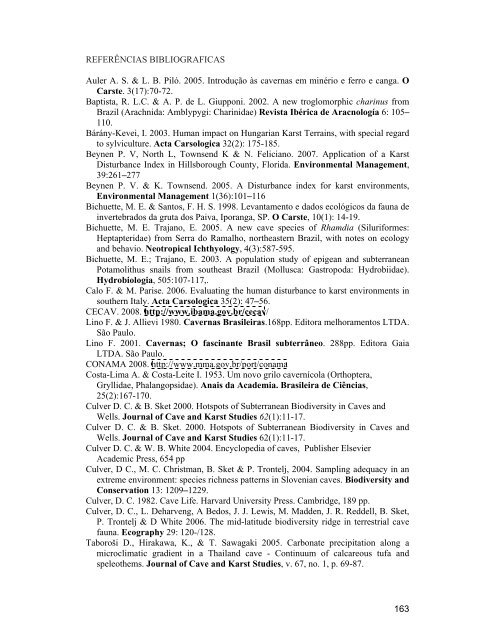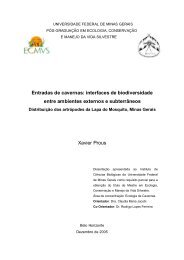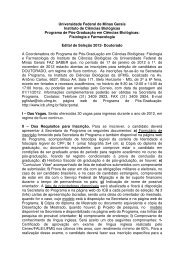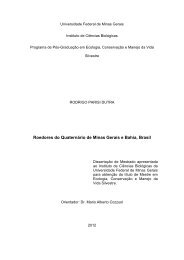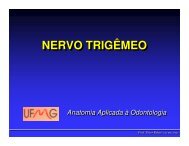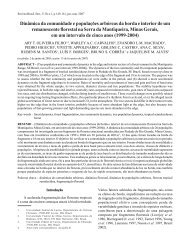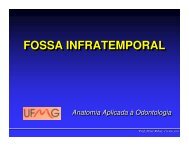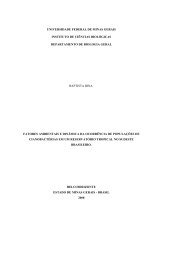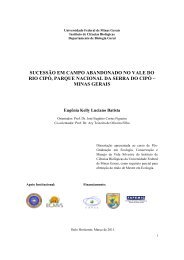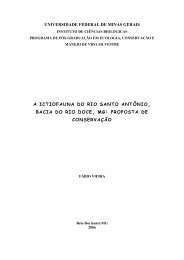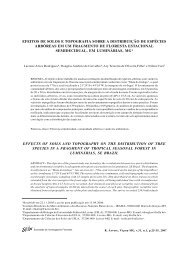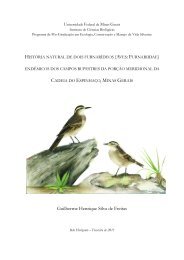ecologi ae conservação das comuni dades de i ... - ICB - UFMG
ecologi ae conservação das comuni dades de i ... - ICB - UFMG
ecologi ae conservação das comuni dades de i ... - ICB - UFMG
Create successful ePaper yourself
Turn your PDF publications into a flip-book with our unique Google optimized e-Paper software.
REFERÊNCIAS BIBLIOGRAFICASAuler A. S. & L. B. Piló. 2005. Introdução às cavernas em minério e ferro e canga. OCarste. 3(17):70-72.Baptista, R. L.C. & A. P. <strong>de</strong> L. Giupponi. 2002. A new troglomorphic charinus fromBrazil (Arachnida: Amblypygi: Charinid<strong>ae</strong>) Revista Ibérica <strong>de</strong> Aracnología 6: 105110.Bárány-Kevei, I. 2003. Human impact on Hungarian Karst Terrains, with special regardto sylviculture. Acta Carsologica 32(2): 175-185.Beynen P. V, North L, Townsend K & N. Feliciano. 2007. Application of a KarstDisturbance In<strong>de</strong>x in Hillsborough County, Florida. Environmental Management,39:261 277Beynen P. V. & K. Townsend. 2005. A Disturbance in<strong>de</strong>x for karst environments,Environmental Management 1(36):101 116Bichuette, M. E. & Santos, F. H. S. 1998. Levantamento e dados ecológicos da fauna <strong>de</strong>invertebrados da gruta dos Paiva, Iporanga, SP. O Carste, 10(1): 14-19.Bichuette, M. E. Trajano, E. 2005. A new cave species of Rhamdia (Siluriformes:Heptapterid<strong>ae</strong>) from Serra do Ramalho, northeastern Brazil, with notes on ecologyand behavio. Neotropical Ichthyology, 4(3):587-595.Bichuette, M. E.; Trajano, E. 2003. A population study of epigean and subterraneanPotamolithus snails from southeast Brazil (Mollusca: Gastropoda: Hydrobiid<strong>ae</strong>).Hydrobiologia, 505:107-117,.Calo F. & M. Parise. 2006. Evaluating the human disturbance to karst environments insouthern Italy. Acta Carsologica 35(2): 47 56.CECAV. 2008. http://www.ibama.gov.br/cecav/Lino F. & J. Allievi 1980. Cavernas Brasileiras.168pp. Editora melhoramentos LTDA.São Paulo.Lino F. 2001. Cavernas; O fascinante Brasil subterrâneo. 288pp. Editora GaiaLTDA. São Paulo.CONAMA 2008. http://www.mma.gov.br/port/conamaCosta-Lima A. & Costa-Leite I. 1953. Um novo grilo cavernícola (Orthoptera,Gryllid<strong>ae</strong>, Phalangopsid<strong>ae</strong>). Anais da Aca<strong>de</strong>mia. Brasileira <strong>de</strong> Ciências,25(2):167-170.Culver D. C. & B. Sket 2000. Hotspots of Subterranean Biodiversity in Caves andWells. Journal of Cave and Karst Studies 62(1):11-17.Culver D. C. & B. Sket. 2000. Hotspots of Subterranean Biodiversity in Caves andWells. Journal of Cave and Karst Studies 62(1):11-17.Culver D. C. & W. B. White 2004. Encyclopedia of caves, Publisher ElsevierAca<strong>de</strong>mic Press, 654 ppCulver, D C., M. C. Christman, B. Sket & P. Trontelj, 2004. Sampling a<strong>de</strong>quacy in anextreme environment: species richness patterns in Slovenian caves. Biodiversity andConservation 13: 1209 1229.Culver, D. C. 1982. Cave Life. Harvard University Press. Cambridge, 189 pp.Culver, D. C., L. Deharveng, A Bedos, J. J. Lewis, M. Mad<strong>de</strong>n, J. R. Red<strong>de</strong>ll, B. Sket,P. Trontelj & D White 2006. The mid-latitu<strong>de</strong> biodiversity ridge in terrestrial cavefauna. Ecography 29: 120-/128.Taboro i D., Hirakawa, K., & T. Sawagaki 2005. Carbonate precipitation along amicroclimatic gradient in a Thailand cave - Continuum of calcareous tufa andspeleothems. Journal of Cave and Karst Studies, v. 67, no. 1, p. 69-87.163


